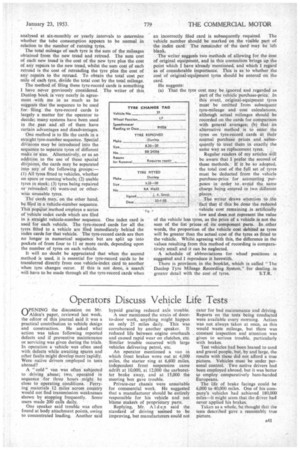Operators Discuss Vehicle Life Tests
Page 51

If you've noticed an error in this article please click here to report it so we can fix it.
QPENING the discussion on Mr. Alden's paper, reviewed last week, the editor of this journal said it was a practical contribution to vehicle design and construction. He asked what action was taken following reported defects and if preventive maintenance or servicing was given during the trials. In operation a vehicle was often used with defects while awaiting spares and other faults might develop more-rapidly. Were native drivers employed in tests abroad?
A " cold " van was often subjected to driving abuse; two, operated in sequence for three hours might be close to operating conditions. Ferrying materials 12 miles across country would not find transmission weaknesses shown by stopping frequently. Some users made 200 calls daily.
One speaker said trouble was often found at body attachment points, owing to concentrated loading. Another said hypoid gearing reduced axle trouble.
A user mentioned the strain of doorto-door work, anything might happen on only 25 miles daily. This was corroborated by another speaker. It reduced life between engine overhauls and caused rapid wear on clutches, etc. Similar trouble occurred with large vehicles delivering petrol, etc.
An operator mentioned a van in which front brakes wore out at 4,000 miles, the starter ring at 6,600 miles, independent front suspension came adrift at 10,000, at 12,000 the carburetter broke away, and at 15,000 the steering box gave trouble.
Private-car chassis were unsuitable for commercial work. He suggested that a manufacturer should be entirely responsible for his vehicle and not blame makers of proprietary parts.
Replying, Mr. Al d en said the standard of driving seemed to be improving, but manufacturers could not cater for bad maintenance and driving. Reports on the tests being conducted were available every morning. Action was not always taken at once, as this would waste mileage, but there was constant inspection and attention was given to serious trouble, particularly with brakes.
Test vehicles had been loaned to sand and gravel people, but, by and large, the results with these did not afford a true picture. Vehicles must be under personal control. Two native drivers had been employed abroad, but it was better to employ comparatively ham-handed Europeans.
The life of brake facings could be 6,000 to 40,000 miles. One of his company's vehicles had achieved 180,000 miles—it might seem that the driver had never applied his brakes. • Taken as a whole, he thought that the tests described gave a reasonably true picture.
























































































































































